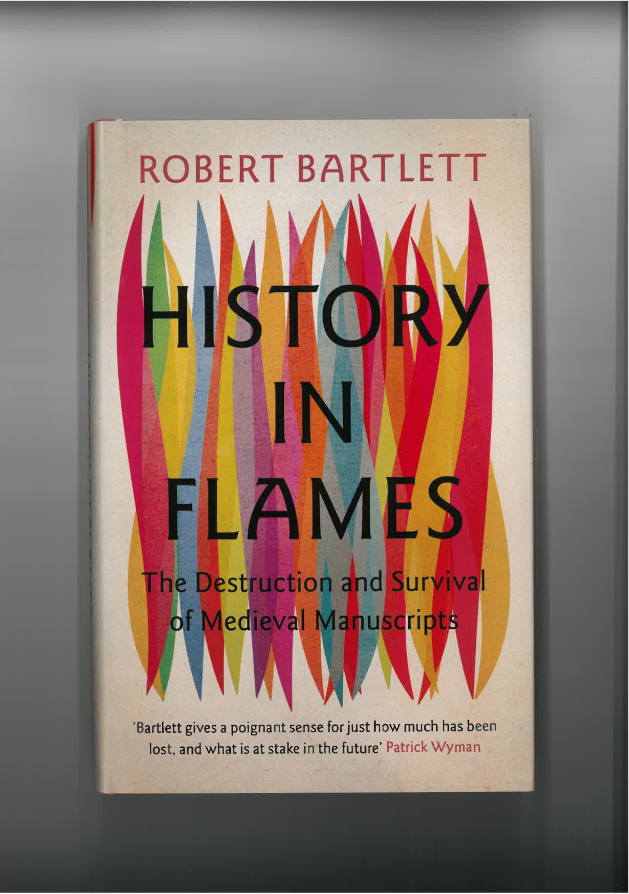ROBERT BARTLETT
Cambridge University Press
£20
ISBN 9781009457156
REVIEWED BY
Murray Smith
Murray Smith is a barrister and history graduate of University College Dublin.
Robert Bartlett, Emeritus Professor of Medieval History at the University of St Andrews, shows his skill and experience in this short but pithy book. He points out that ‘The past is not presented to us on a plate; it is created. We make deductions from things that exist now, deciding to regard them as traces or indications of what happened in bygone days.’ Our knowledge of the Middle Ages depends on medieval manuscripts, books or documents handwritten before printing.
The book looks at five case-studies of how, in archives and libraries in France, Ireland, Italy and Germany, massive numbers of such manuscripts, and other books and documents, were destroyed in mere hours by the explosive power of modern warfare. In two cases he concentrates on specific destroyed manuscripts.
The five incidents of destruction are, first, three libraries, including the town library of Strasbourg, on 24 August 1870 during the Franco-Prussian War, with losses including the late twelfth-century illustrated encyclopaedia The garden of delights; second, the Public Record Office of Ireland (PROI) in Dublin, on 30 June 1922 at the start of the Irish Civil War, with the loss of ‘a vast part of the record of Ireland’s past’; third, the State Archive of Naples (SAN), on 30 September 1943, by German troops during the Second World War; fourth, the Central State Archive in Hannover, including the Ebstorf Map, a thirteenth–fourteenth-century map of the world, in a raid by RAF bombers on 9 October 1943; and fifth, the Municipal Library of Chartres, in a raid by USAAF bombers on 26 May 1944.
These bleak pictures are contrasted with happier ones, when Bartlett talks about his heroes and heroines—the scholars, archivists and others who tried to piece together what has been lost, or at least a record of it, using surviving fragments, duplicate documents, documents sent to other archives, transcriptions and summaries, and facsimile copies. They include, regarding Strasbourg, the magnificently named Count Bastard, who combined a military career with a love of illuminated medieval manuscripts; regarding Dublin, antiquary Sir James Ware and Deputy Keeper Herbert Wood, their and others’ labours resulting in a 3D computer model of the old PROI, containing a virtual archive; and regarding Naples, the SAN’s head, Count Riccardo Filangieri, who sought the help of 350 scholars who worked there before 1943.
In earlier chapters the author gives plenty of background. He looks at the history of medieval manuscripts, the materials used, how they were produced, copied and stored in the emerging libraries and archives, and how many survived into modern times. He looks at research estimating the total number of medieval manuscripts produced in the West, c. ten million, and at how much may have been lost—85–95%. He then gives an account of the narrow escape of the epic poem Beowulf, which survived in only one manuscript. Preserved by antiquary Sir Robert Cotton and nearly destroyed in a fire in 1731, it was copied and edited by Icelandic scholar Grímur Jónsson Thorkelín and was finally published in 1815. This ensured its survival, as that manuscript has become illegible in places.
He details the deliberate destruction of such manuscripts, from the Middle Ages to the 1780s, before coming to the five case-studies mentioned. He points out the paradox that the same impulses of the modern nation state—those that created national libraries and national archives, to make documents safe and accessible, centralised in cities—also made them vulnerable to modern warfare.
In an interview about this book on the podcast ‘Gone Medieval’, when asked which he would pick if he could undo one of the five destructions, Prof. Bartlett chose Dublin’s PROI, because it was ‘the biggest loss of continuous documentation’ of which, in many cases, there were no other copies.
Using Oscar Wilde’s criterion, the book is well written. The author freely admits his limitations and biases. He chose the five case-studies, aware that books and records were also destroyed outside Europe, owing to ‘my linguistic limitations’. After only briefly saying that later material was also destroyed in those case-studies, he explains that ‘I am writing as a medievalist’. He can be acerbic, saying about the declaration of war by France on Prussia in 1870 that ‘this was a time when states still officially declared war’. His love of the medieval period and its manuscripts is very evident throughout.
This book about the past made me think about the future, not just of officially digitised documents but also of our private documents and artwork, only available in electronic form, and whether they will still be both safe and accessible in the future. In the author’s words, if the technology for retrieving digital images becomes antiquated or lost, like the ability to read Mesopotamian clay tablets, ‘the twentieth and early twenty-first centuries will be a new Dark Age’.
I recommend this book not just to those interested in medieval history or carrying out historical research but also to those interested in the past, in what has survived to explain it, and in how things at present can be preserved for the future.

